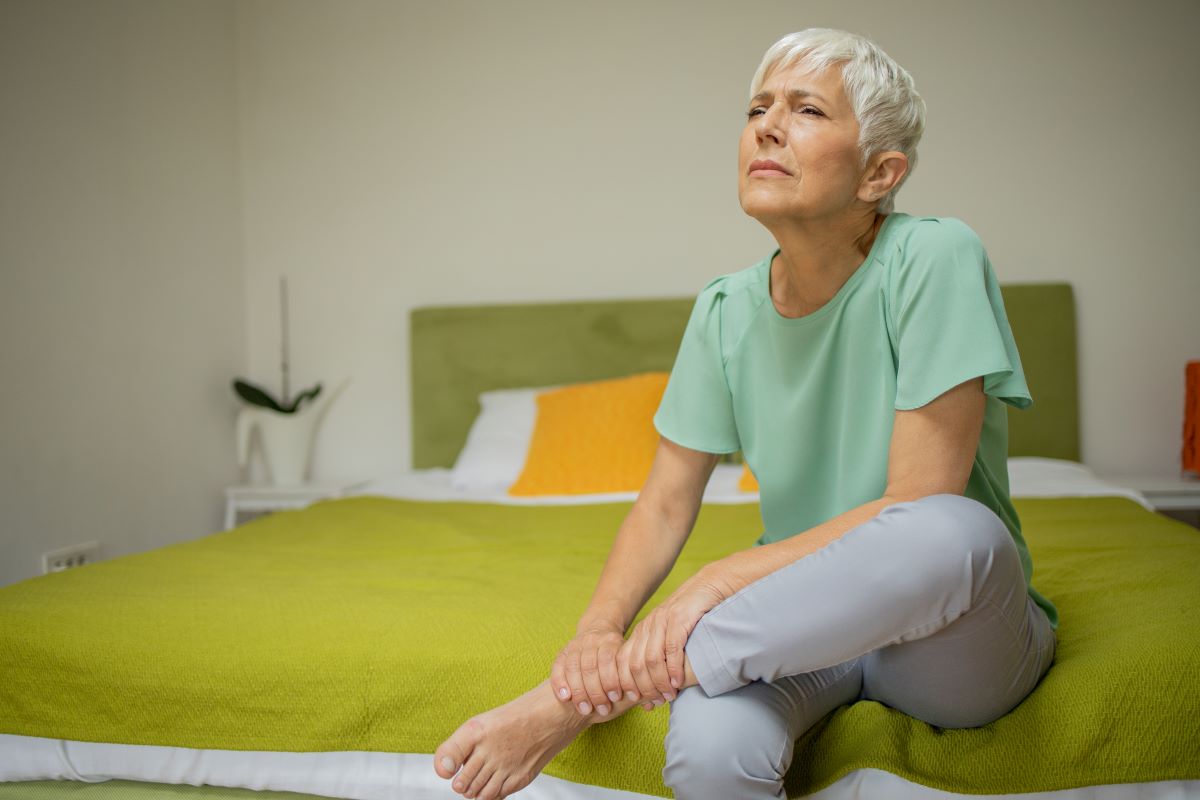Specialist Advice — 9 minutes
What is restless legs syndrome (RLS)?
As one of the abnormal movements that disrupt the process of falling asleep or sleeping, restless legs syndrome (RLS) is characterized by a feeling of discomfort in the legs and sometimes the arms (itching, electric shock, pain, tingling, etc.) when sitting or lying down. The person has an uncontrollable urge to move their legs, which can make it difficult to fall asleep. Over time, sleep deprivation leads to daytime fatigue and drowsiness.

Approximately 10% of Canadians are believed to suffer from RLS, but less than 3% require medication to treat it. Most of them also have periodic limb movements in sleep (PLMS), meaning that they move their legs (and sometimes arms) involuntarily during sleep. RLS can occur at any age, in particular over the age of 50, and is especially common in women, who are affected at twice the rate of men.[1]
Causes of RLS
Primary (or early-onset) RLS does not have a known cause and is thought to be hereditary, especially when the disorder appears before the age of 40. It is thought that an iron deficiency in the neurons may lead to a lack of dopamine, resulting in the symptoms associated with RLS.
In its secondary (or late-onset) form, RLS is thought to result from a condition such as pregnancy or poor circulation, a chronic disease such as diabetes or kidney failure, or a neurological disorder such as multiple sclerosis or Parkinson’s disease. It can also be caused by the use of or withdrawal from medications or drugs.
In addition, RLS can be associated with the following factors:
- Smoking or quitting smoking (temporarily)
- Alcoholism
- Obesity
- Sedentary lifestyle
Diagnosis
Patients are usually aware of the symptoms of RLS, as they occur while they are awake. Consequently, the physician will establish a diagnosis by asking the patient about the uncontrollable urge to move their legs, based on the following clinical criteria:[2]
- Is this urge sometimes accompanied by uncomfortable or unusual sensations?
- Does it begin or worsen in the evening or when the person is at rest?
- Does it disappear, partially or completely, when the person moves?
- Is the urge due to another condition, such as leg cramps, arthritis or muscle pain?
Treatment
Treatment is especially indicated when the symptoms cause prolonged insomnia multiple times per week.
If the RLS is not hereditary, the doctor must address the cause of the syndrome. For example, they may prescribe supplements for iron or folic acid deficiency, substitute a medication that triggered the RLS, or treat the disease that is causing the syndrome.
If the cause of the syndrome cannot be treated, several treatments are available to relieve RLS and encourage sleep, with or without medication. When symptoms are mild or moderate, changing certain lifestyle habits can reduce their intensity or frequency, such as regular exercise (cycling, walking, etc.), adopting good sleep hygiene and avoiding caffeine, alcohol and nicotine. It is also advisable to reduce stress as much as possible by engaging in calming activities such as meditation, yoga, soothing music and relaxation.
When symptoms occur, the following measures can offer relief:
- Massaging the legs
- Hot baths
- Heated cushions or ice packs on the legs
- Vibrating cushion
- Acupressure
- Light stretching
When symptoms are frequent or severe, the physician will probably prescribe medication from the following categories:
- Dopaminergic agents, which act on dopamine receptors in the brain
- Anticonvulsantsor antiepileptics, when sleep is also disturbed by involuntary leg movements
- Sedatives such as benzodiazepines, which help improve sleep. These are usually reserved for the most severe cases due to their addictive potential and side effects, including daytime sleepiness.
- Narcotic analgesics (opioids), which relieve pain and are prescribed as a last resort for severe cases, due to their side effects and risk of addiction
For professional support, we’re here for you.
We provide services that can help your doctor diagnose sleep disorders and determine the appropriate treatment.
Do you want to make an appointment or have questions about an equipment? Chat online with our respiratory therapists.
Sources2
- INSTITUT NATIONAL D’EXCELLENCE EN SANTÉ ET EN SERVICES SOCIAUX. “NEUPROMC – Traitement du syndrome des jambes sans repos,” Ministerial opinion, October 2015, https://www.inesss.qc.ca/fileadmin/doc/INESSS/Inscription_medicaments/Avis_au_ministre/Octobre_2015/Neupro_2015_10_cav.pdf.
- DUNKIN, Mary Anne. “Restless Legs Syndrome (RLS),” WebMD, February 23, 2020, https://www.webmd.com/brain/restless-legs-syndrome/restless-legs-syndrome-rls.









